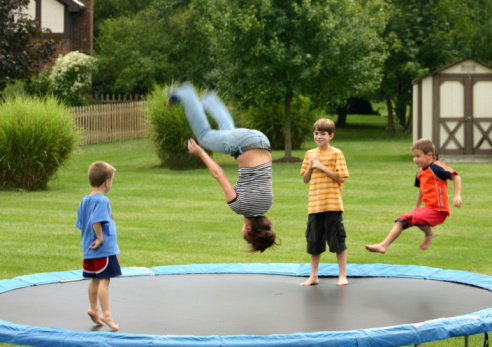Trampolines: Jumping into Danger
 Trampolines provide endless hours of entertainment, exercise, and childhood memories for kids who get to enjoy them. Many parents purchase trampolines with the idea in mind that they want their kids to be outside playing instead of inside watching TV and to them it appears a trampoline is a great activity to release energy. However, recent studies and news stories have suggested that trampolines can be anything but carefree and fun.
Trampolines provide endless hours of entertainment, exercise, and childhood memories for kids who get to enjoy them. Many parents purchase trampolines with the idea in mind that they want their kids to be outside playing instead of inside watching TV and to them it appears a trampoline is a great activity to release energy. However, recent studies and news stories have suggested that trampolines can be anything but carefree and fun.
In reality, trampolines are the cause of hundreds of thousands of injuries to children and young adults each year. Minor injuries such as strains and sprains, as well as extremely serious injuries such as breaks, dislocations, paralysis, and permanent neurological damage are too often the outcome of recreational trampoline use. According to one brain and spinal cord website, twenty percent of trampoline accidents occur to the head and neck, both of which are very vital parts of the human body that are extremely difficult to fully rehabilitate once severely damaged.
According to the U.S. Consumer Product Safety Commission (CPSC) in calendar year 2012, 94,900 people were treated in emergency rooms for trampoline related accidents. Additionally, the CPSC notes that between 2000 and 2009 there have been twenty-two trampoline accident related deaths. CPSC cites the following situations to be the leading causes of death and other injuries in trampoline related accidents: colliding with another person on the trampoline; landing improperly while jumping or doing stunts on the trampoline; falling or jumping off the trampoline; falling on the trampoline springs or frame.
Additionally, the American Academy of Pediatrics (AAP) has officially discouraged the recreational use of trampolines since 1977. They suggest that trampolines are inherently dangerous regardless of the amount of safety equipment used or the level of adult supervision. Another medical association, the American Academy of Orthopaedic Surgeons (AAOS), has issued a statement saying “While safety measure may help minimize severe injuries, the amount of effort required to properly prepare a location, the diligence required to maintain the trampoline mat, springs and frame, and the degree of time and expertise required to properly supervise trampoline use are frequently lacking.” Young children are more vulnerable to serious injuries. In fact, according to CPSC, children under six should be completely prohibited from using a trampoline. Some other safety regulations suggested by CPSC are:
- Allow only one person on the trampoline at a time
- Do not attempt or allow somersaults, because landing on the head or neck can cause paralysis.
- Do not use the trampoline without shock-absorbing pads that completely cover its springs, hooks and frame.
- Place the trampoline away from structures, trees and other play areas.
- No child under 6 years of age should use a full-size trampoline. Do not use a ladder with the trampoline, because it provides unsupervised access by small children.
- Always supervise children who use a trampoline.
- Trampoline enclosures can help prevent injuries from falls off trampolines.
Though trampolines seem like fun toys, useful to entertain children for hours, serious injuries to the body and joints can occur, often leading to emergency room visits or worse. Trampolines present dangerous conditions that homeowners introduce to their own property, but they frequently do not place them in a safe area, provide a netting to keep jumpers from falling off, or follow the recommendations for trampoline safety, such as only having one person jump at a time. When guests are injured on trampolines, claims for damages can be made against the homeowner’s insurance company. If you or anyone you know has been injured in a trampoline accident, please call us at 303-462-2999 for your free consultation.
www.cpsc.gov//PageFiles/137868/085%20Trampoline%20Safety.pdf
www.brainandspinalcord.org/spinal-cord-injuries/trampoline-spinal-injury.html
